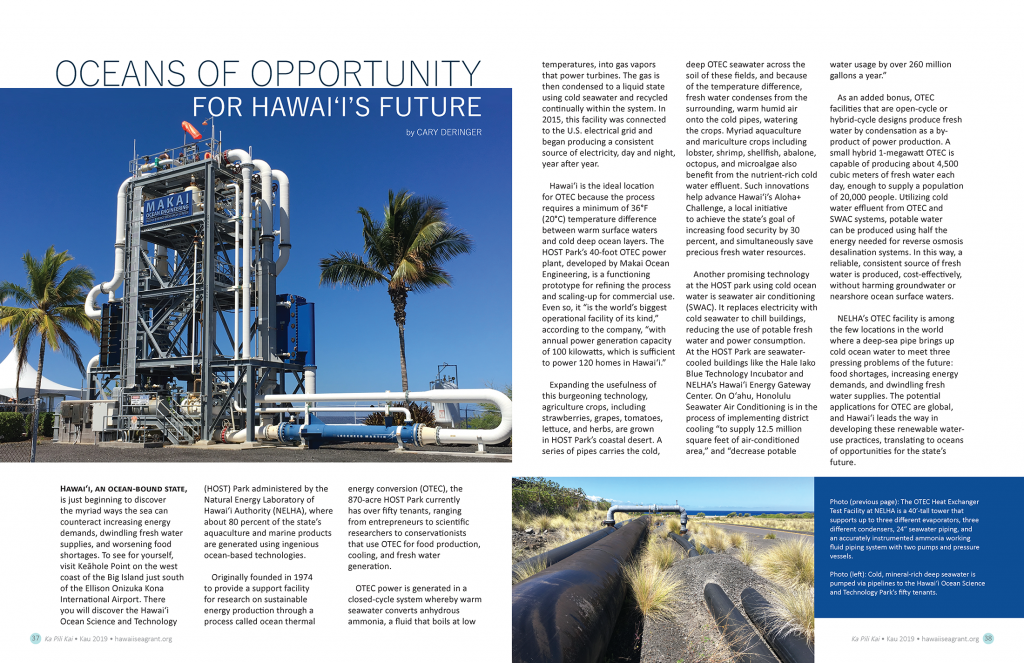Hawai‘i, an ocean-bound state, is just beginning to discover the myriad ways the sea can counteract increasing energy demands, dwindling fresh water supplies, and worsening food shortages. To see for yourself, visit Keāhole Point on the west coast of the Big Island just south of the Ellison Onizuka Kona International Airport. There you will discover the Hawai‘i Ocean Science and Technology (HOST) Park administered by the Natural Energy Laboratory of Hawai‘i Authority (NELHA), where about 80 percent of the state’s aquaculture and marine products are generated using ingenious ocean-based technologies.
Originally founded in 1974 to provide a support facility for research on sustainable energy production through a process called ocean thermal energy conversion (OTEC), the 870-acre HOST Park currently has over fifty tenants, ranging from entrepreneurs to scientific researchers to conservationists that use OTEC for food production, cooling, and fresh water generation.
OTEC power is generated in a closed-cycle system whereby warm seawater converts anhydrous ammonia, a fluid that boils at low temperatures, into gas vapors that power turbines. The gas is then condensed to a liquid state using cold seawater and recycled continually within the system. In 2015, this facility was connected to the U.S. electrical grid and began producing a consistent source of electricity, day and night, year after year.
Hawai‘i is the ideal location for OTEC because the process requires a minimum of 36°F (20°C) temperature difference between warm surface waters and cold deep ocean layers. The HOST Park’s 40-foot OTEC power plant, developed by Makai Ocean Engineering, is a functioning prototype for refining the process and scaling-up for commercial use. Even so, it “is the world’s biggest operational facility of its kind,” according to the company, “with annual power generation capacity of 100 kilowatts, which is sufficient to power 120 homes in Hawai‘i.”
Expanding the usefulness of this burgeoning technology, agriculture crops, including strawberries, grapes, tomatoes, lettuce, and herbs, are grown in HOST Park’s coastal desert. A series of pipes carries the cold, deep OTEC seawater across the soil of these fields, and because of the temperature difference, fresh water condenses from the surrounding, warm humid air onto the cold pipes, watering the crops. Myriad aquaculture and mariculture crops including lobster, shrimp, shellfish, abalone, octopus, and microalgae also benefit from the nutrient-rich cold water effluent. Such innovations help advance Hawai‘i’s Aloha+ Challenge, a local initiative to achieve the state’s goal of increasing food security by 30 percent, and simultaneously save precious fresh water resources.
Another promising technology at the HOST park using cold ocean water is seawater air conditioning (SWAC). It replaces electricity with cold seawater to chill buildings, reducing the use of potable fresh water and power consumption. At the HOST Park are seawater-cooled buildings like the Hale Iako Blue Technology Incubator and NELHA’s Hawai‘i Energy Gateway Center. On Oʻahu, Honolulu Seawater Air Conditioning is in the process of implementing district cooling “to supply 12.5 million square feet of air-conditioned area,” and “decrease potable water usage by over 260 million gallons a year.”
As an added bonus, OTEC facilities that are open-cycle or hybrid-cycle designs produce fresh water by condensation as a by-product of power production. A small hybrid 1-megawatt OTEC is capable of producing about 4,500 cubic meters of fresh water each day, enough to supply a population of 20,000 people. Utilizing cold water effluent from OTEC and SWAC systems, potable water can be produced using half the energy needed for reverse osmosis desalination systems. In this way, a reliable, consistent source of fresh water is produced, cost-effectively, without harming groundwater or nearshore ocean surface waters.
NELHA’s OTEC facility is among the few locations in the world where a deep-sea pipe brings up cold ocean water to meet three pressing problems of the future: food shortages, increasing energy demands, and dwindling fresh water supplies. The potential applications for OTEC are global, and Hawai‘i leads the way in developing these renewable water-use practices, translating to oceans of opportunities for the state’s future.
Browse Ka Pili Kai issues HERE


